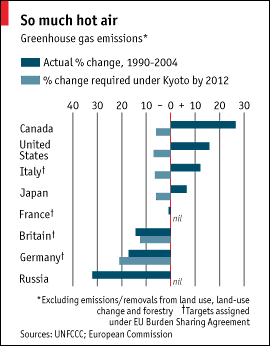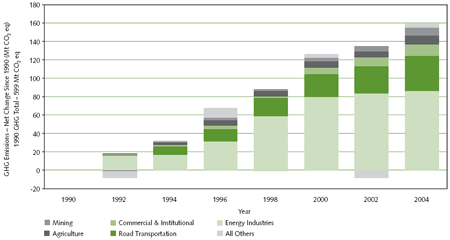
I was startled to see the figure on the right in a recent Economist article. Canada is not only going in the wrong direction when it comes to reducing greenhouse gas emissions, it’s actually doing worse than the rest of the G8, including the United States.
One interesting aspect of Kyoto is that it isn’t indexed to population growth, so countries that accept large number of immigrants (e.g., Canada) are penalised relative to nations that have limited population growth (e.g., western Europe). Ultimately, I suspect this makes sense: the immigrants that Canada accepts are largely from low-carbon nations, and are likely to adopt high-carbon lifestyles upon arrival, so migration is not simply a redistribution of existing emissions. Nevertheless, it does leave Canada at a further disadvantage. Mind you, as the Economist figure shows, the European nations are striving for higher targets than Kyoto anyways – their internal burden-sharing agreement allocates more reduction burden onto high-emission nations.

Looking a little closer (with a little help from an Environment Canada report), we can see the breakdown of the growth in the figure above. I’d like to see this in a little more detail, breaking down energy and transportation a little more finely. Canada’s GHG emissions grew by 26.5% from 1990-2004 (from 599MT to 758MT), and I’ve expressed the 1990-2004 GHG increases in each category as a percentage of 599MT, to show how each sector contributes to the 26.5% growth.
- 8.5%: fossil fuel industries, pipelines and “fugitive sources” (coal, oil, natural gas)
- 7.8%: road and off-road transportation
- 5.8%: electricity generation
- 2.0%: commercial/institutional
- 1.7%: agriculture
- 1.5%: mining
- 0.3%: domestic marine transportation
- 0.2%: domestic aviation
- 0.2%: industrial processes
- -0.2%: rail
- -1.3%: other
- 26.5%: total
This puts in context some of the recent politicking about GHGs. Yes, the fossil fuel industries are a large part of the problem: the oilsands are a major source of carbon emissions, and the growth of exports in Alberta is clearly a big part of our emissions (8.5/26.5 = 32% of growth in GHGs). But, road/off-road transportation (29% of growth) and electricity (22% of growth) have also contributed significantly to our recent increases in emissions.
Breaking down the 7.8% from road and off-road transportation further:
- 3.6%: heavy-duty trucks (gasoline & diesel)
- 2.9%: cars and light-duty trucks (gasoline, diesel, propane and natural gas)
- 1.5%: off-road transportation (construction, agriculture, snowmobiles, ATVs)
- 7.8%: total
Heavy-duty trucks are a significant part of road transportation growth. Keep in mind that this is part of other changes in the freight industry, including a 0.3% increase in marine emissions and a 0.2% decrease in rail emissions, giving a 3.7% net increase for freight. The switch from cars to SUVs, the ongoing decline of transit usage, and the ongoing rise in kilometres travelled per person contributed to the 2.9% contribution by cars and light-duty trucks. Off-road usage is a bit weird, and I haven’t looked into how they measure this distinction.
Now I have a sense of how my new field fits into the bigger GHG picture: passenger transport makes up over 10% of Canada’s growth in GHG emissions. Stopping that growth is clearly an important start towards stabilizing national (and global) emissions, but that’s just the beginning – the latest negotiations are talking about a 50% reduction in global emissions relative to 1990. If developing countries are allowed to increase their per capita emissions, Canada would need something closer to a 75-80% reduction in emissions for a net 50% reduction globally.
Phew. I’m sure that’ll be a cinch.
Wow, we’re pathetic. Great summary! I inhaled that Economist special report on climate change; it’s really well-written.
Incidentally, do you know what the population growth has been from 1990-2004?
I wonder- is the growth in electricty generation the same as electricity consumption? Or does Canada import/export a significant fraction of its electricty?
I’ve recent heard estimates that per capita electricity usage in San Diego is skyrocketing due at least in part to “phantom” electrical devices; as offices/houses generally have increasing numbers of gismos plugged into the wall, which may be “sleeping” but not off…
According to the EC report (executive summary), population growth was 15% over that period.
I’m not sure about the electricity generation/consumption. I imagine BC and Quebec are exporters, due to plentiful hydroelectric; but that clearly doesn’t contribute much to GHG emissions. Manitoba might export as well… not sure where they get their electricity. So I imagine most of that generation growth corresponds to consumption growth. (I suppose I could control for population growth and recalculate all these numbers… but whatever.)
I’ve heard the complaints about “off” devices sucking juice from the wall, but I suspect it still doesn’t add up to that much. The media loves to focus on easy/stupid fixes like that… and sure, it would be a painless thing to fix. But at the end of the day, I imagine the big culprits are still air conditioning, space heating and water heating – the painful ones that would require major behaviour change to fix.